|
FAQs about Stony Coral Health/Disease/Pests
9
Related Articles: Coral Pests and Disease; pests, predators,
diseases and conditions by Sara Mavinkurve,
Quarantine of Corals
and Invertebrates, LPS
Corals, True or Stony Corals, Order
Scleractinia, Propagation for Marine
Aquarium Use,
Related FAQs: Stony Coral Disease 1, Stony Coral Disease 2, Stony Coral Disease 3,
Stony Coral Disease 4, Stony Coral Disease 5, Stony Coral Disease 6, Stony Coral Disease 7, Stony Coral Disease 8, Stony Coral Disease 10, Stony Coral Disease 11,
Stony Coral Disease 12,
Stony Coral Disease 13,
Stony Coral Disease 14,
Stony Coral Disease 15,
FAQs on Stony Coral Disease by Category: Diagnosing:
Environmental (Pollution/Poisoning, Lighting...),
Nutritional,
Social (Allelopathy),
Trauma,
Pathogenic (Infectious, Parasitic, Viral)
Predatory/Pest,
Treatments
& By Family:
Caryophyllid Disease, Fungiid Disease, Faviid Disease 1, Cnidarian
Disease, Quarantining
Invertebrates,
|
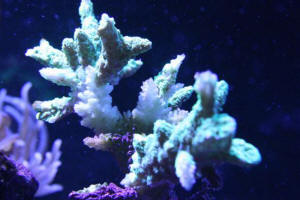
|
|
More questions
What are chances of recovery of the wall hammer and lobo in
attached pictures, & ID --
1/27/10
<Mmm, not bad>
Lobo had an accident and ended up out of water for a while. The
hammer just went downhill since I got it 3 months ago. It is now
almost horizontal and I am hoping it will come back.
I have branching hammers and they are all doing well, even
growing new heads.
<These may be "duking it out" with the poorly
specimen chemically. Am pretty sure we've (you and I) chatted
over allelopathy issues>
My id question is the red 'leaf' on the side of the lobo.
There are a few of them and they look like half of a red
mushroom. The third picture is a close-up of it. It even has
bumps like a mushroom would have but I am guessing it might be an
algae of sorts.
Thanks,
Sam
<Mmm, actually... my bet would be/is on a sponge of some sort
here... Maybe even a colonial Ascidian. Cheers, BobF>
|
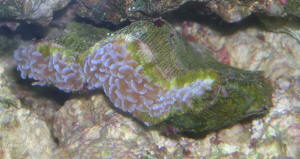 .jpg)
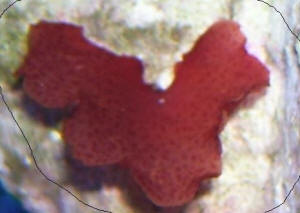 |
Re: More questions --
1/27/10
Hi, BobF,
Yes, we've (you and I) chatted over allelopathy issues. I am
hoping they will get used to it and recover.
<Me too>
I do use carbon. I change it about every 2 weeks.
As far as the red 'leaf' I do not see any siphons. Also it
is very thin about like an onion skin. I haven't tried touching
it yet. In any case it is a very nice bright red So I will enjoy it
while it lasts.
Thanks,
Sam
<Perhaps an artifact of the photo... Could you take others...
more highly resolved? At varying angles, and send them along?
BobF> |
General Query, Stony coral hlth. reading
1/13/10
Hi Friends,
<Ranjith>
Happy new year [still is new :-) ]
<Aye>
My question is regarding a reef tank with the following details
Tank size - 30Gal
Tank age - 3-4 months. Water and LR taken from existing tank.
Tank dimensions - 28"x14"x18" [LxDxH]
Lighting - 2x55watt CF [6500K], 2x36watt CF [actinic], 5x1watt LED,
1x5watt LED, Lighting is 8" above water column.
Photoperiod - 12 hours
Circulation - 1 Vortech Mp40 running at 30% speed, chiller return.
<Some gear for a small system!>
Filtration - Nano Remora. Pulls out 1/4th collection cup skimmate [tea
colored]. I am not sure if this is too wet?
<Not likely a worry... the tank is "new"... the volume,
quality of the/this skimmate will change with time>
Water Parameters - no3/5ppm, ca/450ppm, PH/8.3 [consistent across start
and end of photoperiod] temp/26 C, Specific Gravity/1.030 [plan to
reduce this over 3 days to 1.025] the hydrometer was showing 1.025 and
realized this only when I got a refractometer yesterday night and
checked.
<I see, and not an uncommon differential>
Other details - 2" aragonite approx 1mm size, 25-30kgs premium LR
Inhabitants - one 3" red and green open brain, one 5" cup
coral, one 3" red Montipora [plating variety], 2 snails, many many
bristle worms and pods.
Feeding - Twice weekly I feed the tank with a mix of freeze dried
krill, Cyclops, coral frenzy, minced mackerel
<Is this very fatty?>
or other marine fish soaked in Selcon.
Maintenance - water was really old and had not done water changes for
more than a month or even more.
This Sunday, did a 12% wc [with 1.030 SG since I was not aware of the
hydrometer's mistake]. I started correcting the SG from yesterday
night [replaced 5% tank water with plain water]. This brought my SG to
1.028.
I plan to do 5% replacement again tonight to bring it to 1.026 and a
2.5% next day to come to 1.025.
WC will thereafter be 5% weekly [do I need to do a 10% weekly?]
<Is a good practice, percentage>
The Montipora was nicely red when I got it. Over a week after addition
it started losing color. I see lots of white and green replacing the
red on it.
<Mmm, could be "many things"... see WWM re Acroporid
Systems, Health...>
The mouth still opens when I add food to the tank.
<... the "mouth" on Montipora?>
1. Is this dying? What could be the cause?
2. Is the green color a color change or just algae taking over?
<Could be... read here: http://wetwebmedia.com/acrodisf6.htm
and the linked files above>
The open brain was having red on the lips and florescent green
tentacles and mouth. This also started losing the red color at the same
rate and time as the Montipora.
<I would hold off on adding more life here for a few months.>
The lips area went from red to light pink and the green also became
lighter.
1. Is this dying? What could be the cause?
<... see WWM re Trachyphylliids>
The cup coral is not doing great but polyps do not come out much in the
day or night. If I feed it the polyps do show extension.
Please could you help me understand what to do to get this tank back on
track.
<What you seek is very likely archived on WWM... learn to/use the
search tools, indices. Bob Fenner>
Thanks in advance
Ranjith
|
Brown jelly disease? Mmm, no
12/22/09
Hello WWM,
I've had a problem with my reef tank that just won't go
away and I'm in need of expert help. About two months ago my
Hydnophora developed a quarter-sized, brown slime patch. I
assumed Cyano, cleaned off the coral
and dipped it in some iodine based coral dip. It returned fully
about two weeks later and that's when I noticed some brown
stringy material on some other corals as well. It progressively
got worse to the point of covering
other SPS corals in the tank. Not big slime patches but many
individual strings of the slime. I proceeded by syphoning off the
strings daily and performing 10% bi-weekly water changes on top
of the two gallons being
replaced daily from the syphoning. Everyday the same corals had
the strings in the same place so I'm assuming it's the
individual coral making it.
<I wouldn't make this assumption>
After a couple weeks of constant cleaning it was almost gone but
now it's starting to return. Also, sometimes the strings will
be on my Halimeda plants and on the rocks and sometimes they have
little air bubbles in them.
The strings just seem to breakup like slime not with substance
like a plant. Could it be Dinoflagellates?
<Highly unlikely. Do you have a microscope?>
Could it be STN/RTN with Cyano attaching?
<Likely just the latter... what re net causes here?>
I'm lost and at the end of my rope. Please help!
<Umm... water quality test results?>
My system: 125 gallon reef mostly SPS, refugium with Gracilaria,
large Octopus skimmer, GFO reactor, 630 watts T5 lighting, 4
Koralia powerheads, live rock wall, community fish. The GFO
reactor
<Whose, what media are you running in this?>
was installed about a month prior to the problem
<I would turn this device off, take it off-line... your corals
need some soluble inorganic phosphate>
and the T5 lights changed at the same time. If I missed anything
or for more info on my system and pics you can see my reef club
site post here:
http://www.thescmas.com/forums/showthread.php?t=5433<http://www.thescmas.com
/forums/showthread.php?t=5433>
Thanks JLaurence.
<"Looks" like BGA... again, there is either some
sort of nutrient imbalance or an essential nutrient limitation
going on here likely... Remove the reactor, look to other means
of control. Read here:
http://wetwebmedia.com/bluegralgae.htm
and the linked files above. Bob Fenner>
|
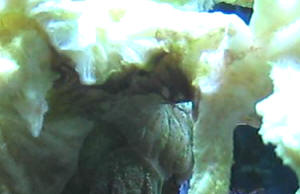 |
Coral pest worm 11/8/2009
WWM crew,
<Scott>
55 gallon tank with hang on back refugium that contains a RDSB all
levels calcium nitrate etc are at optimal levels, way too much live
rock, not sure how much (rock taken from former 100 gallon tank at last
residence, new place to small for something so big sadly had to get rid
of the livestock that wouldn't do in a smaller tank) I do a 5
gallon water change every 2 weeks and use a 2 part supplement to
maintain calcium/alk also add iodide to the water. 2 150 watt metal
halide lights 2 HO fluorescent lights.
needle wheel impeller style skimmer. the tank has been up and running
here for only about 3 1/2 months but all the rock and when I changed it
over the water from the old tank that was running for about a year was
used in the new tank, didn't experience any new tank affects when I
did this. I have 2 false percula clowns 2 green chromis and 1 cleaner
shrimp, a mixture of LPS, SPS corals, SPS is all very close to the
surface to ensure they get enough light.
This morning I noticed that part of my candy cane coral seemed to be
missing. on the inner part of the polyp where it is green instead of
the reddish brown area. I just fed this coral yesterday and did not
notice this yesterday. I fed the coral some formula one marine pellet
that I discovered my LPS corals have a feeding response to in addition
to the
mysis shrimp I had been using. Any ways on further inspection I found
what seemed to be some type of worm the worms are white and skinny, I
attempted to remove the worm with a pipette using suction. when I did
this I noticed many more around the same area, I took the coral out of
the water and attempted to get the worms off, I moved the coral to the
refugium. I purchased the coral about a month ago. the corals health I
thought looked improved after I started feeding it, doubt it was being
fed by the last owner.
Anyways I want to ask the following, is there any dip/bath you would
recommend giving this coral to remove the parasites,
<Mmm, not parasites... predators possibly... but much more likely
these are just feeding opportunistically (if at all) of the coral
here...>
is there danger of these worms infesting other corals, if so should I
treat every coral in my tank? This is my first experience with any
coral disease/pest and I am unsure what to do a search on the internet
did not provide much help. as my main display tank I left bare bottom
to ensure easy cleaning I do not think a wrasse which I found suggested
being used would be a good addition to my tank, besides the last fish I
wanted to add was a mandarin dragonet as soon as my tank is old enough.
I know they do better in bigger tanks but with the tank having so much
liverock it almost reaches the surface and the addition of the refugium
I am hoping will be good enough for it, I definitely have enough pods
in the tank currently. I do not want to overstock so I would prefer not
to use any biological controls. For some reason my camera is messing up
as far as transferring the pictures to the computer to send out,
another problem to deal with great, so hopefully my description will be
enough. I do not think a picture would add much the pests seem to be
thin white worms between about 2-3cm long very thin, in the picture I
took you could barely see them.
Thank you in advance for all of your help, I have found your website to
provide the best information on the hobby and it has been a great help
in my reefkeeping addiction.
<... I wouldn't over-react here. There are many species of
worms... the vast majority of which are more help than harm. I suspect
this Faviid had some trouble a month back when you bought it... I would
maybe step up your iodide/ate dosing, but otherwise just ignore these
worms. Bob Fenner>
Bleaching Question, thermal, corals
8-28-09
Recently my cooling fans bit the dust. I'm not sure of the exact
date but it may be as long as a week (they're or were very quiet
and I did not notice that they were not running). The temp in my tank
has climbed. I am
awaiting replacement fans. My tank's temp is usually between
78F-79F. It went as high as 86F and I have managed to keep it at 80F
while waiting for the fans to be shipped. I have noticed, with much
pain and guilt, that several of my corals are bleaching. As my other
parameters (ph, etc) are stable, I assume this is from the dramatic
change in temperature. What is the likelihood that they will recover?
Is there anything I can do to aid them?
<Very likely. It's also very likely that they'll recover -
make sure you keep all parameters stable, and feed well for the few
months it will take them to recover>
Thanks.
<Anytime. Mike Maddox>
Water parameters out of whack? More questions re killing
stony corals 6/22/09
Hi all, I have been out of the hobby for about two years and decided to
make a come back. At any rate, I decided to do a SPS/Clam/Zoa tank.
So here is the issue, I added some frags SPS from a friends tank about
4 weeks ago...all dead with in a week. Their tissue sloughed away.
<Oh, now that doesn't sound good... This was the first life you
added to a new system?>
two weeks went by and I bought a frag from a LFS, It's showing
signs of tip burn and I have had it for about 3 weeks. I bought another
4 frags from a LFS (Idaho Grape Cap, Orange Cap, Leng Sy Cap, and a
green slimer) The caps are doing ok (Idaho grape is starting to show
tissue slough). The green slimer is starting to turn white at the base
and start to have some of the tips turn white.
<...>
The clam looks great, but the a few of my Zoas have closed up and
appeared to have died.
<What? The Zoanthids could have poisoned the Scleractinians... see
WWM re them, allelopathy>
The local reef group (salt-city.org) I am in thinks that my Alk is the
issue, but I am looking for some direction as far as where to start
because I don't think that Alk is it.
<... Ok>
Here are my tank parameters:
Tank is a bare bottom 120 gallon with 40 gallon sump.
<Why no substrate?>
Skimmer: Deltec AP702
CA reactor: Geo 612 (not in use)
<Why?>
Running Phosban and Activated carbon 24/7
<Again, why? Cnidarians need the materials these remove...>
Lighting: 2x250 watt DE Hamilton 14k MH with Lumen Bright reflectors
and 2 54watt T5 actinic for supplementation
<Is this much more than these were exposed to previously?>
Circulation: 2X Tunze 6100s on a Neptune Aquasurf
Tank has been running for 3.5-4 months.
water parameters :
Temp: 79-79.3
pH: 8.11-8.23
Spec. Grav: 1.026
dKH: 12 (4.29 mEq/L)
Calcium (460-480)
<Too high>
Mag: 1140
PO4: 0 (Undetectable)
<Needed>
Nitrate: 0 (Undetectable)
<Ditto>
Ammonia: 0 (Undetectable)
Top off/Make up TDS: 0-1
Salt used for water changes is half Instant Ocean half Oceanic. Last
water change was done yesterday at the advice of my local forum. I did
25% in hopes of getting the dKH reduced (my tank was at 12)...the dKH
remained the same, 12. I tested the new water prior to doing a water
change and it was at 12 dKH also.
I'm trying to solve the mystery that is causing things to die
off.
<Understood... see the questions above? Search them on WWM. Bob
Fenner>
Thanks!
Travis
Re: Water parameters out of whack?
6/22/09
Thanks Bob! I will do some research and ask if I have any more
questions. thanks again, for all your help!
Travis
<Welcome Travis... do gather data... and we'll chat further...
Together we can work this out. BobF>
|
Filamentous algae growth on coral skeleton
6/11/09
Dear Crew,
I have successfully transferred the full content of my nano to a
larger 80g system following your advice and all is well and
thriving - THANK YOU!
<Happy we have helped you out!>
New set-up includes sump with refugium, skimmer with O3,
Rowaphos, carbon, DSB and lighting with 250W of 14,000k MH and
96W of blue and actinic T5s.
Readings are: pH:8.18; Alk:3.43meq/L; ORP: 420mV; <A bit
high.>NH3/NO2/P: 0; NO3: 10ppm;
Mg: 1350ppm; Ca: 460ppm;<Also artificially high.> Sal:
35.5ppt; T: 26C.
I have 2 issues:
1/ I have the impression that I run the Alk on the high side of
acceptable levels, as I need to add about 1 tsp of Seachem marine
buffer every second day to keep the pH up where it belongs. What
are the risk associated to too high Alk levels?
<Your water can only "hold" so much, eventually your
Ca and Mg would drop.>
Should I consider another supplement?
<Your level is at the upper range. If you wish to lower it
just dose less.>
2/ The other issue is outstanding from my previous set-up and
remains unsolved: 2 of my corals (Seriatopora Hystrix and
Montipora Digitata) have very tiny blotches of naked skeleton
amidst their healthy tissue where there are now growths of
filamentous algae. The blotches originate from the suboptimal
lighting conditions in my previous set-up. In the new set-up, the
corals are fine with great polyp extension and good colouring,
and healthy growth of new tissue and tips (see pics).
<Ahh, nice.>
I can't however get rid of the algae blotches. I regularly
scrape the algae off with a sharp blade,
but it keeps growing back. Any suggestions on how to solve this
problem?
<I would just pull what you can off as it gets long enough to.
Otherwise with good system husbandry
your corals will eventually grow back over these patches.>
Thank you very much,
Yours,
Tim
<Welcome, Scott V.>
Re: Filamentous algae growth on coral skeleton
6/11/09
Before you make any replies, please note the modification
regarding the circulation in the tank - which I am certain you
would have pointed out as being a potential source for the
issue...
Best regards,
Tim Van den Brande
<Looks good, Scott V.>
|
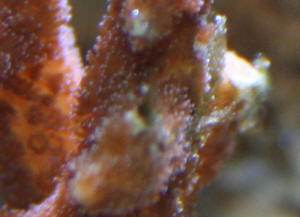 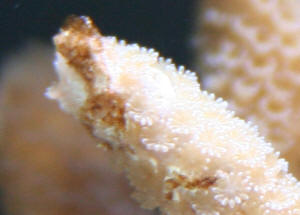 |
|
HELP!! Algae killing corals 5/31/09
Greetings Bob & Crew!
<Hey Ray.>
Got a major problem that has me perplexed as to why it is
occurring and how to solve it.
<Okay.>
For the last 2 months, I have green algae thriving in my tank and
it is now killing off my stony corals. My prized turquoise Acro
colony is nearly 80% wiped out right now, my green slimer Acro is
not fairing well, and my neon pink Birdsnest is starting to show
signs of trouble. So far, my blue Acro colony is doing fine, as
are most of my soft corals, LPS corals, anemones, inverts and
fish. What is happening is this algae covers and attaches to the
corals, killing them off.
<And as it kills it fuels more algae growth.>
Attached is a pic of the coral colony suffering the worst.
I have added nothing to the tank in a while (almost a year), and
nothing
gets added without strict QT.
Tank info:
50 gal tall, 20 gal sump/fuge
50 lbs LR in tank and another 20 in fuge along with tons of macro
algae
(cut back on a regular basis).
About 2" of live sand in DT with another 2" in fuge
(sand less than a year old as I put new sand in with last
move).
<May be part of the issue, the sandbed is better off less than
an inch or more than 4". Two inches is a no man's land
that can act as a nutrient/detritus sink.>
Running an ASM G3x skimmer, got over 800 gph in random water flow
in DT,
<I would actually up this with the SPS.>
250w Hamilton 14k MH with a Lumenarc-III reflector and a PC bulb
in fuge, MH running 11 hours per day and the fuge light
alternates for 12 hours (MH on during day, fuge at night) Have a
phosphate reactor with Seachem PhosGuard Also have a HOT
filter whose filter pads totally clog up within 3 days and need
to be changed.
<A disturbing sign.>
Parameters: SG 1.025, pH 8.28, Calcium just under 400, dKH 8
(working on that), and nitrate, nitrite, ammonia, phos, and
silica all zero.
I have been doing 10-gallon water changes weekly and try to suck
out as much algae as I can with each one. I have also been doing
a 5-gallon
change mid-week as the algae seems to be growing faster than I
can remove it. Also changed out the media in phos reactor,
and added carbon to HOT filter. Skimmer producing the same
amount of dark, foul skimmate. Other things I have done is
to change out the MH bulb, adjust the current flow pattern, cut
back on fish feeding. Nothing seems to work. None of my
snails (5 different types), hermits or urchin touch the
stuff.
<They will not.>
I am out of ideas. After nearly 8 years of keeping reef tanks, I
feel like giving up because this green algae has nearly ruined my
prized tank and corals that started out dime-sized and grew to
dinner-plate size are nearly dead.
Please help.
<Nothing new or groundbreaking to say here. From what you
describe I would in fact deepen your sandbed, add some more flow
to the tank, take a look at your feeding (be very sparing) and
possibly your source water. See:
http://www.wetwebmedia.com/algaeconMar.htm for more.
One thing not mentioned here, what is the stocking level in the
tank, what fish are in it?>
Thanks
-Ray
<Welcome, Scott V.>
|
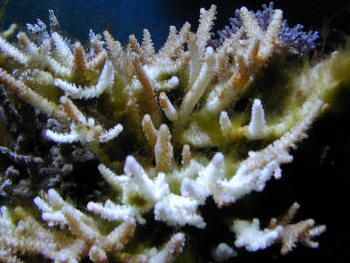 |
|
Re: HELP!! Algae killing corals
6/2/09
Thanks for the reply!
<Welcome.>
Answer to a few of your comments.
I took another look at the sandbed and most of it is just over an
inch.
The Nassarius snails keep moving it around along with water
flow.
<Good.>
I use only RO/DI water with a TDS of 0. I flush the membranes
regularly and change filters when TDS goes over 5. I am using Red
Sea Coral Pro salt mix. Fish load has not changed since tank set
up. Was fine for 8 months and then this algae appeared. 2
Perculas, 2 Pajama Cardinals, 2 blue-green Chromis, a small
2" Foxface (will be going to a bigger tank soon), skunk
cleaner, blue urchin, orange brittle star, and snails.
<Sounds fine.>
As far as more flow, I looked things up and way underestimated
the flow.
I have 6 powerheads
2 Seio Super Flows (620 GPH each)
2 Hydor Koralia (400 GPH each)
2 Maxi Jets (295 GPH each)
Return pump (Quiet one 3000 with 780 gph, probably more around
400 with 5' head height)
And my HOT filter that is another 350 GPH.
Therefore I am running well over 3000 gph.
<Good again.>
Feeding is frozen foods mostly. Only use the dried foods when
someone watching the tank when I am out of town, and then it is
minimal (give them a measuring spoon with strict instructions,
and they know to follow them).
<Frozen foods can be a source of algae fuel. Do be sure to
defrost the food first and drain off any liquid. This can make
quite a large difference.>
As far as the carbon I use, only the stuff that comes with the
filter (Whisper). Been using it for years and never had a
problem.
And looking in the tank today, I saw an Aiptasia appear!!! I have
not had one of those in my system in over 5 years!
<Uh oh.>
Nothing added without QT so I have no idea where this thing came
from.
<Likely lurking where you could not see before.>
This is getting frustrating. Anything else I could try?
Different phos media?
<The ferric media's can be much more effective, but can
also strip the water of too much phosphate.>
Change lighting schedule?
<I would not, it is a treatment of the symptom, not the
problem.>
Was thinking keep fuge light on longer to give that algae a
chance to get more nutrients out.
<May help.>
I am afraid that this will spiral out of control soon and then I
will have a FOTWLR and a ton of algae. I am even debating setting
up an emergency frag tank and take frags of all my corals to
preserve them in case of disaster. Money is a little tight for
that though, but I am getting to that point.
Any other input would be helpful.
<Just not much new to say here. There is a source somewhere
fueling this algae. You will have to take a look at your total
system and practices to figure out where.>
Thanks
-Ray
<Welcome, Scott V.>
|
High Magnesium and corals losing color 3/15/09
Hi, I have a 175 gal reef. Calcium is 450 mg/l alkalinity is 9 dKH,
Magnesium is 1800 ppm.
<Mmm, I would remove a good deal of the water in this system, and
re-fill with new seawater with less Mg>
Everything was fine until a friend of mine gave me this magnesium
supplement he sells, but he gave it for free since the instructions
were wrong, I couldn´t find the right instructions in his
homepage either, so I added 2 full caps and the day after I noticed
that my Montiporas were losing color. Only the Montis: rainbow,
superman, orange capricornis and green capricornis, the Monti
palawensis was not affected and neither was the sunset Monti. Acros and
all other corals were not affected.
<... not yet>
The Montis affected look rather pale, the Magnesium level was probably
around 1600 ppm and this supplement raised it to 1800 ppm. Is this the
reason for the pale colors?
<Could well be... directly or not>
Some people suggest that is good to have high magnesium as it will
improve coralline etc.
<Mmm, not to my knowledge... about three times Ca conc. is ideal...
more gets worse>
My Mag levels have always been high, the average was 1300 ppm until I
started dosing Mag supplements then it went up. A curious thing is that
my green Monti cap has never had a good coloration, it has always
looked pale, I´m wondering if high mag has this effect on
corals?
<Can, yes>
Now the question is how to lower the Mag, I heard this is done with
water changes, I did a water change last week before adding the Mag
supplement which raised Mag, so I´m wondering if I can just
wait 4 more weeks to do the water change as usual or I should treat
this as an emergency and do the water change now to lower magnesium?,
is there an urgency?.
<There is... again... diluting with new water of lower [Mg] is
called for... stat>
Also for my calcium I use Seachem's advantage calcium which
"maintains magnesium" does that mean it will keep Mag at 1800
ppm as long as I keep using it?.
<Depends on how much you use... I would use three times Ca levels as
a target, and NOT add the Advantage if Mg is about three times this
concentration>
Also what is going to happen with the corals that went pale in
coloration, will they die from this?
<Hopefully not>
, or they will just go back to normal in time?.
<Hopefully so>
Did they become pale because of High Mag levels or because the increase
on Mag levels was to much to fast?
<Can't say... but is a possibility that it is the sudden and/or
finished high degree. Bob Fenner>
Stony issues, hlth... allelopathic cascade event
likely 10/21/08 I have two main issues: 1)
injuries on my tongue coral and pagoda cup; and, 2) tissue recession
and/or bleaching on my Pocillopora and my Hydnophora. I have a 150 gal
aquarium with a 30 gal refugium, 3x150W HQI (10,000K) + 4x96W (420nm)
Actinic, bought new 14 months ago. Calcium is 400, Alkalinity 3.0, Temp
78.5 (controlled by chiller), pH 8.2 (relatively constant, as we have
an automatic reef doser, with two-part A and B solution). <I take it
the last are administered to the refugium or in/with new water during
change-outs> We have had our tank for fourteen months, and have had
no problems. Most of the corals in the tank have come from our previous
smaller tanks over the last five years. For instance, the tongue coral
and the pagoda cup are over four years old, and we moved them into our
consolidated 150-gal August 2007. Here's the problem with those two
- they were stung by a falling frogspawn. <Ooohhh, can be fatal>
It fell and touched the edge of each coral, leaving a visible injury.
The tissue has decayed, and I have noticed my cleaner shrimp and
blue-tipped hermit crabs picking at the injuries. I moved the tongue
into my quarantine tank under PC lighting, and I'm considering
moving the pagoda cup. Is this course of action recommended? <Mmm,
to avoid the picking mentioned? Actually not if the removal by these
crustaceans is/was only the damaged tissue> My idea is, without the
shrimp and crabs picking on them, the tissue will grow back, and they
can be returned to my display tank. <Mmm... I'd rather had you
cover the corals in place... with inverted "strawberry
baskets" or such> Please note that this is not brown jelly, and
the dead tissue area affected reveals the underlying white skeleton.
The area in question on each one is about one square inch, relative to
approximately 10 square inches of total healthy coral. The polyps are
extending, and the rest of the coral looks great. Please let me know
your opinion on this LPS injury problem. <Very common... all else
being maintained, usually not fatal> Regarding my second issue,
above, over the last week, my Pocillopora, which is over a year old,
and has been thriving (growing, polyps extended, branching), has
started to bleach from the inside out (ie the middle of the coral has
turned white, while the tips have retained their color and polyp
expansion). However, the problem seems to be getting worse. I am
thinking about fragging this coral, as it is medium size. Should I do
this, and what is the likely cause of this tissue
necrosis/bleaching/recession? <Nothing obvious here... perhaps (the
most likely guess) a result of the reaction of the other two
Scleractinians to being stung by the Euphyllia> Because the
temperature and other water parameters are stable, and the coral has
not been moved since we've had it, could it be due to decreased
light intensity from aging bulbs? <Doubtful if the other stony
corals are unaffected> Also, we recently switched our A&B
solution to C-Balance from Aquaphilic. Could this also be a
contributing factor? <Again, doubtful... this variously diluted
Peter Wilkens/Two Li'l Fishies product has been implicated (due to
sloppy, inconsistent dilution) at times... but not recently> We
switched it on the first of the month, and have just developed problems
over the last week. I do not want to lose this coral, as we have had it
for over a year, and it has been thriving, along with the rest of our
tank, which has over forty species of soft and stony corals. All other
corals have great polyp expansion, and are growing and healthy, at this
time. However, this morning I awoke to find a small area of bleaching
on my otherwise healthy (and huge) Hydnophora, which we have had nearly
five years, and which has over doubled in size (larger than a bowling
ball) since we put it in the new tank about 14 months ago. One of the
fingers only has bleached at the tip. Should I cut that finger off
before it spreads? <Mmm> Or should I leave it alone and hope it
grows back. <I would do this last> Could the Pocillopora and
Hydnophora have the same problem? <Yes> What is the recommended
course of action for both of these corals? <Patience... and reading:
http://wetwebmedia.com/cnidcompppt.htm and the linked files above>
p.s. We haven't lost any corals, or had any problems whatsoever,
since we set up our 150-gal over 14 months ago, from five smaller tanks
that we had kept over the previous five years. Please help, so we
don't lose the ones that are hurting. P.P.S. It may help you to
know that we have six fish (3 tangs, a blenny, a clown, and a royal
gramma), and some inverts (snails, blue-tipped hermit crabs, a cleaner
shrimp, and a coral banded shrimp), which all live peacefully together.
No other corals are in the vicinity of the problem corals, and no other
corals appear to have any issues at this time. We are preparing to do a
15% water change, and await your response. Thank you in advance for
your help. <Please do keep me/us abreast of further
developments/observations. Bob Fenner>
|
|

